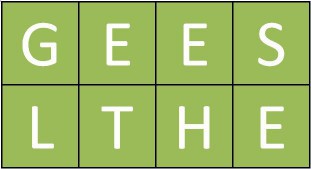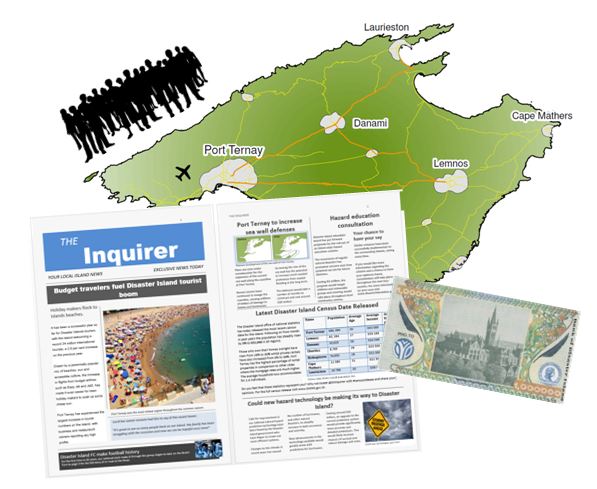By Joseph J. Kerski, University of Denver and Esri.
Abductive reasoning (also called abduction, abductive inference or retroduction) is a form of logical inference that goes from an observation to a hypothesis that accounts for the observation. It ideally seeks to find the simplest and most likely explanation. In abductive reasoning, unlike in deductive reasoning, the premises do not guarantee the conclusion. One can understand abductive reasoning as “inference to the best explanation”. The fields of law, computer science, and artificial intelligence research have renewed interest in the subject of abduction.
Abductive reasoning can be effectively taught through spatial thinking and analysis with the use of Geographic Information Systems (GIS) technology and methods. Through the overlaying, swiping, and display of maps and imagery in a GIS, students are encouraged to make observations about the patterns, relationships, and trends, or lack of pattern. They can then form a hypothesis about why the pattern exists and how it came to be. They can then test that hypothesis against the data, by running a set of spatial statistical techniques, by testing different models, by symbolizing and classifying the data in different ways, and by examining different regions of the world at different scales, testing whether the relationship holds in all regions and scales, or just some.
All of this is what I find most valuable about teaching with GIS–it is one of those few tools that allow for inquiry, investigation, hypothesis testing, changing the variable(s) analyzed, all in one environment. In fact, GIS was created to be that very thing—a toolset that would allow problem solving and investigation. I like to think of GIS as a means of enabling students to investigate the “whys of where”. These investigations can occur at the local level, where hypotheses could include “Food stores in my community will be geographically dispersed, while antique shops will be more geographically clustered, “ or, “There is a positive correlation between median age and median income in my community.” But the questions can be in an optimal location style, such as, “Where is the best location for an urban greenway in my community?” These questions can occur at the regional scale, such as “How have the land use patterns changed in the past 25 years, where have they changed, and why?” and at the global scale, such as “What is the pattern of earthquake depth and magnitude in close proximity to plate boundaries? What is the relationship between birth rate and life expectancy, by country, and what is reason for the patterns that I see?”
As we begin examining the data, I find that it is best if the students give a hypothesis. In one of the examples above, I ask students to state what they hypothesize the pattern of global earthquake magnitude related to the major types of plate boundaries to be, and then do the same thing with global earthquake depth. I also ask them to state why they stated their hypothesis that way. What components of past geographic knowledge are they bringing to bear on their hypothesis, or are they truly “in the dark” about this specific type of spatial relationship without prior knowledge?
With today’s web-based GIS tools, students can visualize and analyze real-world phenomena in 2D and 3D, and increasingly in real time. They can collect their own data with smartphone apps with their own equipment and then map and analyze that data. They can communicate their results with web mapping tools such as multimedia story maps and share these maps with others. I find that students think holistically about problem solving through the use of these tools. Through these web based GIS investigations, students also must deal with issues such as data quality, data volume, scale, location privacy, crowdsourcing, and the proper use and citation of web images and data. They must also think about which maps that they should share with the public, which maps they should share with a smaller group such as their own research colleagues or classmates, and which maps they should not share at all.
Consider this example that I have taught with many times from secondary school to university level. After examining the types of crops grown in the USA, and after conducting research on the type of climate and the amount of precipitation that is required for cotton, students hypothesize about where cotton will be grown. They then observe the pattern of cotton production on an interactive web map. They note that their hypothesis was confirmed, at least in part: Cotton exhibits a southerly pattern: Thus, latitude does matter. But although some of these southerly areas receive enough precipitation, others are semiarid. How can cotton be grown in these semiarid regions? After further investigation, students discover that irrigation from river diversion makes cotton production possible in southern Arizona and irrigation from deep groundwater extraction makes cotton production possible in west Texas. Students then begin to ask, “Should cotton be grown in these semiarid areas? Is this the best use of natural resources?” At this point, the students, not me, are driving the inquiry. In the best spirit of geographic inquiry, student investigations lead to additional questions, and the investigation continues using the web maps as one of the tools of study. Thus, the map layers and the GIS tools are means by which the students investigate the issues. The maps are not used merely to find “where” but help students understand the “whys of where.” And they help move students forward in their thinking from “what are past and current patterns” on to “what would be the best plan in the future for this community, region, country, or global phenomena.” Thus they use the tools to envision a better and more sustainable future.
Consider another example below from a GIS-based investigation: Say after observing the map of ecoregions and population density that I created online, that the student’s hypothesis is that the savanna regime division is generally characterized by higher population densities in the region of East Africa. Then, students investigate such questions as: “Does the savanna suffer from biodiversity loss to a greater degree than less populous ecoregions? What are other factors that can help explain the pattern of population density in this area? Is it topography, water availability, proximity to roads, agricultural production, or some other reason? If I zoom in to a larger scale, does the population density remain higher in the savanna than other ecoregions at that larger scale? Why or why not? What are the long term implications for the ecoregions in this area? How do these patterns compare to those in other regions, including the region in which I live? How can I use what I have learned to make wiser decisions about land use and ecoregions in the future?”
How have you used hypothesis testing and abductive reasoning in your own teaching or your own research?










